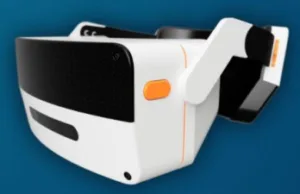Offered by SimulaVR, the Simula One is a stand-alone virtual reality headset designed with a focus on work related applications. In company literature, the headset is represented as able to replace a user’s computer and to “serve as an entire workstation on the user’s face.” The headset has several uncommon features.

The first of these is that the headset uses Linux Desktop. Given this choice, the headset is aimed at software engineers and developers that desire the programming freedoms provided by the Linux OS.
A second uncommon feature is that the headset has a detachable compute pack. By removing the compute pack from the back of the headset, the Simula One can be tethered to any Windows or Linux based PC. In this configuration, the headset is suitable for gaming. This allows, for example, the use of SteamVR gaming (given that the user has a controller from an appropriate, alternative virtual reality platform.)
The Simula One can also be used in a so-called “pancake” or 2D mode when working outside of virtual reality. In this mode, the user can plug a conventional monitor into the Simula One compute pack and proceed to work as if the monitor was attached to a conventional computer.
A video appended to the end of this article illustrates and describes the capabilities of the Simula One. The headset is pictured in the figure below. The headset has been described in the press as having a “retro design.”
The Simula One headset with the compute pack in place.
Some of the features and specifications of the Simula One headset are as follows:
- Display resolution is 2448 x 2448 per eye
- Field of view is 100 degrees
- Optical system is based on three element non Fresnel lenses
- 5 pixels per degree (Note: The PPD is not uniformly distributed. Using “lens tricks,” 35 PPD is achieved in the inner foveal region transitioning to less PPD in the outer regions.)
- Refresh rate is 90 Hz
- IPD is 55 – 77 mm with independent mechanical position adjustment for each eye
- Eye relief is 13-17 mm (The design allows for users that wear eye glasses.)
- Head and 6 DOF inside out hand tracking provided by UltraLeap (formerly the company Leap Motion.) The headset does not support controllers.
- Two wide angle, high resolution RGB cameras. These can be used to support an augmented reality passthrough mode which, in turn, can allow the user to see their keyboard and surroundings while working.
Specifications of the compute pack include the following:
- i7-1165G7 processor
- 16 GB memory
- Iris Xe graphics
- 1 TB SSD
- Wi-Fi 6
- Bluetooth 5.2 allowing connection to keyboards and mice.
- 5 mm audio jack
- Exposed ports:
- 1x USB4 (including Thunderbolt 4)
- 2x USB-C 3.2 Gen 2/DP Alt-Mode
- 2x USB-A 3.2
The operating system used by the Simula One is called SimulaOS. SimulaOS is represented as the world’s first virtual reality dedicated Linux distro. It purports to provide a highly customizable, open source Linux virtual reality Desktop experience allowing users to run normal Linux applications in virtual reality. SimulaOS is pre-installed on the Simula One, but can be removed and replaced with other Linux distros by a user that desire a different configuration.
SimulaOS is built over the Godot game engine and NixOS. (Note that Godot is a 2D and 3D, cross platform, free and open source game engine released under the MIT license. Further note that NixOS is a Linux distribution built on top of the Nix package manager. It uses declarative configuration and allows reliable system upgrades. NixOS is included to enable reproducible headset configurations and an easy system rollback if a problem should occur.)
The Simula One headset is compatible with any app that runs on Linux Desktop. Such apps include Firefox, Chrome, LibreOffice, Emacs and Vim.
Three versions of the Simula One headset will be offered.
- The Founders Edition: is a standalone headset with luxury design features like a matt black finish, brass accents and a wood panel. The preorder price is $2700. The regular price is $4,999.
- The Standard model is also The preorder price is $1,499. The regular price is $2,699
- A tethered only version. The preorder price is $1,149. The regular price $1,999.
It can be noted that the company is offering headsets at preorder prices as an alternative to the previously announced intention of initiating a Kickstarter campaign.
Headsets are planned to ship before the end of 2023. The company is, however, hopeful that delivery can begin between Q4 2022 and Q1 2023. When delivery begins, priority will be given to shipment of Founders Edition headsets. – Arthur Berman

